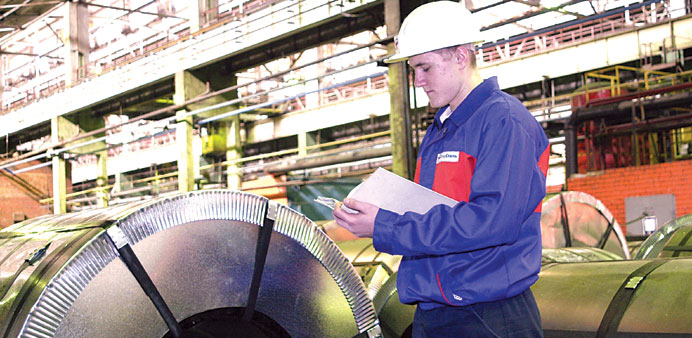A worker checks the quality of coils of hot rolled steel at a Severstal steel mill in Cherepovets, Russia. Severstal, which rallied 57% last year as the dollar-denominated RTS Index plunged the most since 2008, has slid 9.1% from this year’s high as the rouble rallied the most among emerging-market currencies.
Bloomberg/Moscow
Russian steelmakers are falling out of investors’ favour as slack demand and a strengthening rouble dim the profit outlook for some of the companies that had skirted a broader selloff amid the country’s financial crisis.
Severstal, which rallied 57% last year as the dollar-denominated RTS Index plunged the most since 2008, has slid 9.1% from this year’s high as the rouble rallied the most among emerging-market currencies. OAO Novolipetsk Steel, which jumped 21% in 2014, has tumbled about 16% from this year’s peak.
While most stocks sank last year amid international sanctions and tumbling oil prices, a 46% drop in the rouble boosted the steelmakers as they made sales abroad and covered costs in the local currency. BCS Financial Corp last week cut its outlook on Russia’s steel industry to negative and recommended selling Severstal and Novolipetsk, saying investors have largely ignored a strengthening rouble, domestic steel prices at an all-time high and shrinking global demand.
“A lot of investors are looking at the steel industry as if the rouble prices are still devalued, disregarding the fact that the rouble has strengthened, meaning profitability will decline,” Kirill Chuyko, the head of equity research at BCS Financial Group, said by phone on Monday. “The appreciation in the rouble, along with decreasing demand for steel globally and really high prices domestically, will inevitably affect the performance in the steel sector.”
Economists surveyed by Bloomberg estimate that gross domestic product will probably contract 4% this year as crude trading around the lowest levels since 2009 exacerbates the impact of international sanctions linked to the Ukraine conflict. Oil is Russia’s biggest export.
Severstal and Novolipetsk Steel pay wages and other costs in roubles while earning dollars or euros for exported steel.
The rouble has appreciated 5.1% this month amid a tenuous cease-fire in Ukraine and Brent crude prices holding above $50 a barrel.
While industries that benefited from the weaker rouble are now taking a hit, the rally in the currency, which has gained 17% to 58.7458 per dollar since the end of January, might be short-lived, according to Oleg Popov, a money manager at Moscow- based April Capital asset management.
The median estimate of analysts surveyed by Bloomberg is for the rouble to weaken to 64.75 in the third quarter.
“I don’t see the trend of the rouble’s strengthening lasting,” Popov, who oversees about $500mn, said by phone on Monday. “I think this is short-term.”
Spot prices for steel-making coal are down 14% this year after a 28% slide in 2014 amid a supply glut. Steel output in China will shrink this year as consumption has peaked, a representative of the China Iron & Steel Association said March 11.
Shrinking consumption in China will further diminish steel demand, pushing down prices, while domestic prices of the metal will have to be lowered to match the rouble rally, BCS said in its report dated March 20.
Severstal’s global depositary receipts were steady at $11.53 by 10:15 am in London yesterday. Novolipetsk Steel gained 0.8% to $12.95. The Bloomberg-Russia US Equity Index added 1.4% to 57.70.
“If the rouble continues strengthening, metal producers will suffer the most since they export almost everything they process,” Vadim Bit-Avragim, a money manager in Moscow at Kapital Asset Management, which oversees 175.4bn roubles, said by phone. “The market is concerned that the rouble might strengthen to 55 against the dollar.”

